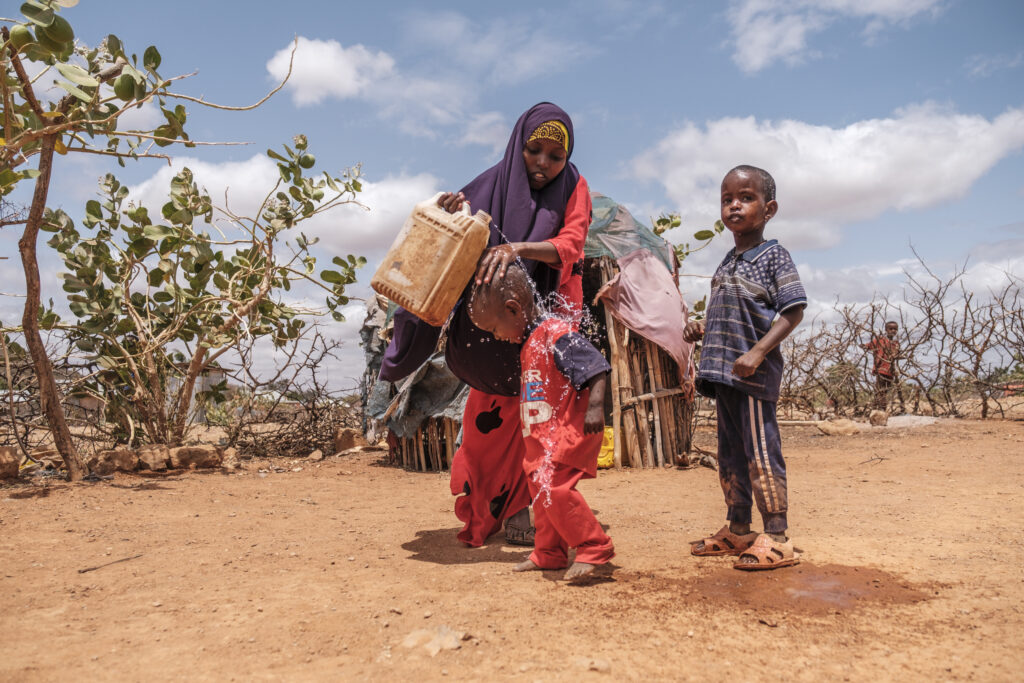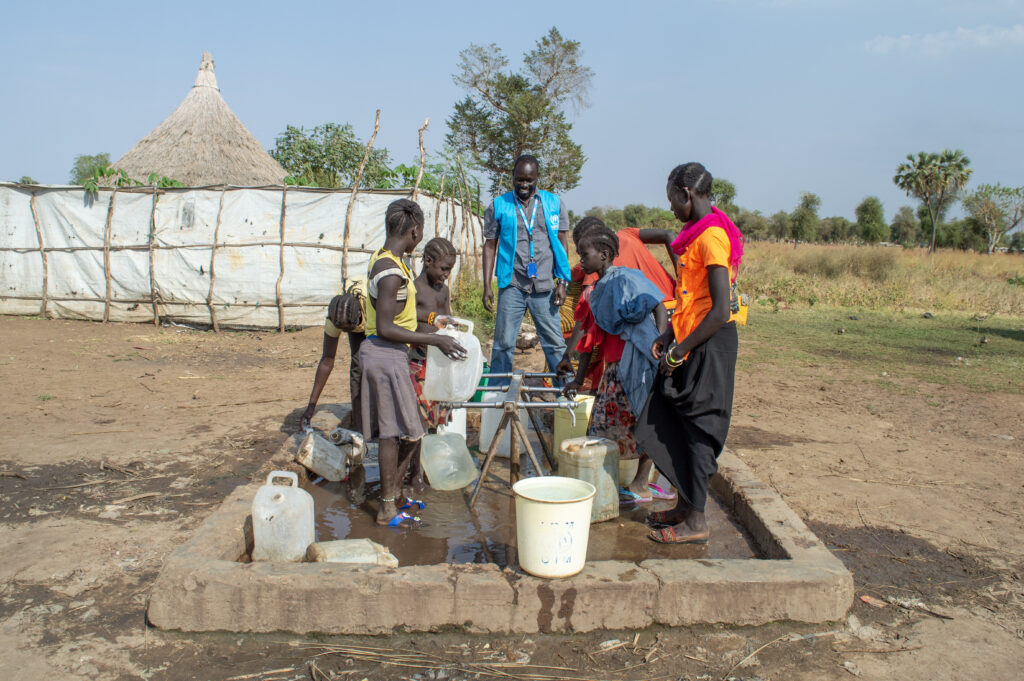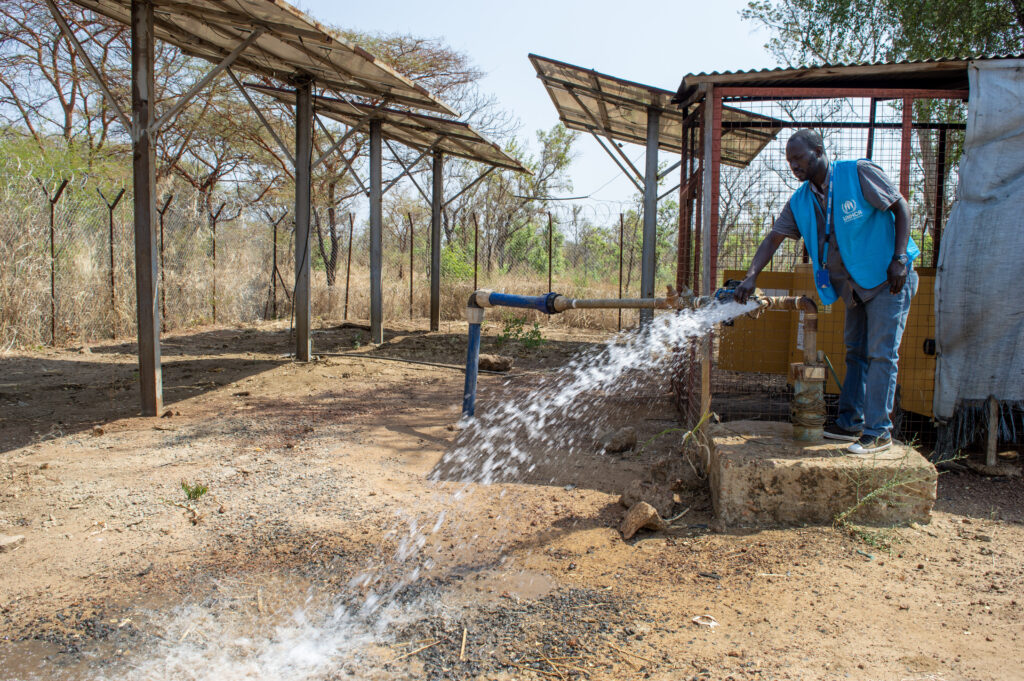By UNHCR, the UN Refugee Agency
In 2021 alone, some 23 million people were displaced within 137 countries and territories because of extreme weather events and the impact of climate change. In the Horn of Africa, the worst drought in four decades has created dire humanitarian conditions for millions of people, forcing families to flee their homes.

Bishara Adam Nurs, a refugee pregnant mother from Somalia, washes one of her children in front of her house in Bokolmayo refugee camp, Ethiopia. Photo: © UNHCR/Eduardo Soteras Jalil
Climate shocks – increasingly unpredictable weather events like drought and floods – are also worsening food insecurity, leading to violence over shrinking resources. This in turn further fuels displacement. We recently saw this in Cameroon’s Far North, where herders, fishermen and farmers clashed after Lake Chad tributaries dried up. Villages were razed and tens of thousands of people fled, mostly to Chad.
One of the biggest impacts of climate change is water scarcity and the contamination of water sources due to floods, droughts, and other severe weather conditions. In 2023, over eight million forcibly displaced people will rely on UNHCR, the UN Refugee Agency, and its partners for access to basic water, sanitation, and hygiene (WASH) services. A vital part of UNHCR’s work is herefore to ensure that refugees have access to safe and sufficient water.
Water is key to humanitarian work
Since 2014, UNHCR has increased the amount of water supplied in refugee operations, reaching an average of 20 litres of water per person per day in 2021. However, this standard is not reached everywhere and will become harder due to climate change.
A key part of UNHCR’s work is therefore focused on improving our understanding of the water resources in refugee hosting areas through systematic aquifer monitoring, using remote sensors and integrated water resource management so that water resources are used efficiently and sustainably.

Joseph Wani, UNHCR Water, Sanitation and Hygiene (WASH) Associate, monitors water usage by refugees at the Old Belila water point in Doro refugee camp, South Sudan. Photo: © UNHCR/Mary Sanyu Osire
For example, UNHCR systematically collects and analyses data through its WASH Monitoring System to understand details around access to water and sanitation services. UNHCR has also put in place real-time monitoring to have live information on available water and to identify potential gaps in services immediately.
In addition, UNHCR is working hard to reduce greenhouse gas emissions by systematically pursuing more resource-efficient alternatives, including powering water systems through renewable energy. One of UNHCR’s key initiatives, Project Flow, will accelerate the solarization of water boreholes, helping to drastically cut carbon emissions and save costs over the longer term.
With one of the largest field presences of any humanitarian agency, UNHCR is working in some of the most fragile contexts where conflict and climate vulnerabilities meet – where millions of people are forcibly displaced and in urgent need of assistance and protection. Only with urgent action, collaboration and strong partnerships can this complex humanitarian crisis be addressed.
Facts about Project Flow
UNHCR supports the operation of over 480 boreholes around the world that serve millions of refugees. Each of these have power needs – whether fulfilled by hand pumping or by motors that classically use diesel power. While UNHCR has solarized around 42 per cent of its diesel-powered water pumps, hundreds of large water systems and boreholes continue to run on diesel power. The average borehole uses some 40,000 litres of diesel per year, equivalent to 110 tons of carbon dioxide emissions per borehole per year.
Funded by the Grundfos Foundation and with contributions from Denmark and Germany, using innovative financing mechanisms UNHCR aims to solarize half of its boreholes by the end of 2025. Phase 1 of the project is focusing on six countries, covering 40 water systems in Ethiopia, Mauritania, Rwanda, South Sudan, Sudan, and Zambia. Field-based feasibility studies have begun in these countries, with detailed solar designs to be developed based on the results and analysis of the field work. These designs will allow Project Flow to determine which water systems to prioritize as the solarization begins in 2023.


